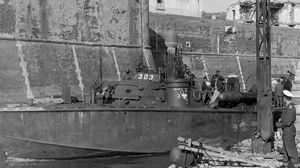Catalogue number 104009
US Navy PT303, detail
The United States Navy only became interested in high speed torpedo and gun boats (PT boats in American nomenclature) when they became necessary for naval operations, notably in the Pacific and the Mediterranean Sea. This photograph shows one of the 197 boats mass produced by Higgins Industries, New Orleans, USA, thanks to standardisation of engines, armament, equipment and fittings. PT306 "Hogan's Goat" is seen here in the pass at Taranto, Italy late 1943 or early 1944. Two twin 12.7mm machine guns are in turrets either side of the bridge with what looks like the barrel of a Bofors gun on the aft deck and a 20mm Oerlikon cannon on the foredeck. The warhead of one of the four 53.3cm torpedoes can be seen just aft of the bridge. A British Royal Navy officer is looking on maybe impressed - or otherwise! - by the customised turret and the jacket of the crew member.
14.3cm x 10.7cm Gelatin silver print
|
 |